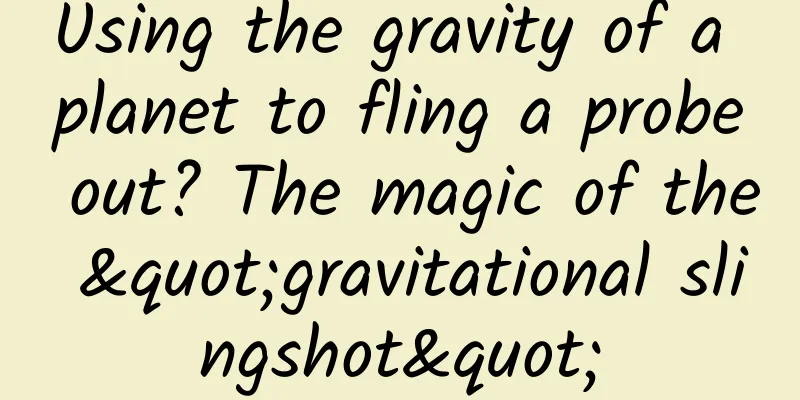Using the gravity of a planet to fling a probe out? The magic of the "gravitational slingshot"

|
In the setting of "The Wandering Earth", in order to move the earth, humans have installed 10,000 super nuclear fusion engines on the ground, each 11,000 meters high, which can generate a total thrust of 150 trillion tons. Strictly speaking, the unit of force should be Newton, which is about 150 trillion Newtons. We know that the mass of the Earth is about 600 trillion kilograms. Using Newton's second law, it is easy to calculate the acceleration of the engine pushing the Earth, which is approximately equal to 0.000000025 times the acceleration of gravity on the Earth's surface, which is very, very small. It takes a long time to accelerate the Earth to the speed of escaping the Sun. Based on the Earth's speed around the Sun of 30 km/s, the Earth's speed of escaping the Sun is 42 km/s, that is, a speed increment of 12 km/s is required. In addition, the show also sets a scene where the Earth flies to Jupiter. You may ask, since we are flying outside the solar system, why do we have to have a date with Jupiter? This is because using Jupiter's gravitational slingshot can speed up the Earth. Earth escapes Jupiter's gravity and embarks on a long journey to Proxima Centauri (still) What is the "gravity slingshot"? A gravitational slingshot, or gravity assist, is a method of using the gravity of a large celestial body to change the speed of a probe. It can increase or decrease the speed, and can also change the direction of the speed. Wait a minute, Jupiter's gravity is a conservative force, which means that when the probe approaches, it is an acceleration process, and when the probe moves away, it is a deceleration process. The two effects cancel each other out. If we analyze it this way, the probe cannot obtain energy from Jupiter's gravitational field, but can only change its flight direction. What's the problem? For simplicity, let's take an example from a real-life scenario: When you were a naughty kid, a car was coming from the front at a speed of V1, and you kicked a football at a speed of V2, which happened to collide head-on with the car. At this time, the speed of the football relative to the car is V1+V2. Assuming that the football and the car collided in a completely elastic manner and there was no kinetic energy loss, then when the football bounced off the car, the speed relative to the car was also V1+V2, but the speed of the football relative to the ground was V1+V2+V1=2V1+V2, which means that the football gained a 2-fold increase in the speed of the car. Because the mass of the car is much greater than that of the football, we can get the answer mentally without using complicated energy and momentum conservation formulas. Understanding this simple thought experiment makes it much easier to understand the gravitational slingshot. Relative to Jupiter, the speed of the probe did not change when it came in and flew away, but Jupiter is moving around the sun at a speed of 13 kilometers per second. If the probe enters Jupiter's gravitational field from the front of Jupiter, and then goes around Jupiter from behind and exits the gravitational field, it would be equivalent to an elastic collision between the probe and Jupiter! Assuming that the speed of the probe is parallel after entering Jupiter and flying out of Jupiter's gravitational field, then relative to the sun, the probe has gained an increment of 2 times Jupiter's speed. But in reality, the probe enters Jupiter's gravitational field at a certain angle, the deflection angle is not that large, and the speed increment obtained is not that large, but the principle is the same. Then there is another question, where does the probe's increased energy come from? It does not come from Jupiter's gravitational field, but from Jupiter's kinetic energy. In other words, after the probe increases its speed, Jupiter's speed will decrease a little. Given the huge difference in mass between Jupiter and the probe, the speed reduction is negligible. The slingshot effect can not only accelerate the probe, but also decelerate it. The principle is the opposite process mentioned above. Application examples of gravity slingshot Gravity slingshot is a very mature aerospace technology with a wide range of applications in reality. The first time humans used a gravity slingshot was in 1959, when the Soviet Union's Luna 3 probe flew behind the South Pole of the Moon, used the Moon's gravity to go around to the back of the Moon and took the first image of the back of the Moon. The gravity slingshot not only changed the probe's flight orbital plane, but also slightly increased its speed. The Soviet Union's Luna 3 probe sent back the world's first photo of the far side of the moon Pioneer 10 was launched in 1972 and arrived at the Jupiter system in 1973. After exploring Jupiter, it used the slingshot effect to accelerate and then embarked on a journey to interstellar space. Pioneer probe In 1973, Pioneer 11 was launched and arrived at the Jupiter system in 1974. After exploring Jupiter, it used the gravity slingshot to change the magnitude and direction of its speed and then flew to Saturn. After exploring Saturn, it used Saturn's gravity slingshot to accelerate again and embarked on a journey to interstellar space. Pioneer 10 and 11 are famous probes that carry "Earth's business card". The so-called Earth's business card is made of gold-plated aluminum plates, on which are depicted a pair of naked men and women, the flight trajectory of the probe, the coordinates of the solar system, and the hyperfine structure transition of neutral hydrogen atoms representing the level of human technological development. If one day in the future, these two probes are captured by alien intelligent life, they may be able to parse out basic information such as where the probes came from and what level of civilization they came from. The naked man raised his right hand to say hello, indicating that the people on Earth are friendly and come for peace. Earth's business card carried by the Pioneer probe In 1974, after NASA's Mariner 10 probe flew past and explored Venus, it successfully used Venus's gravitational slingshot to slow down, lowering the perihelion of the probe's orbit to near the orbit of Mercury, and then conducted a flyby exploration of Mercury. Mariner 10 probe In 1977, NASA launched the Voyager 2 and Voyager 1 probes respectively (yes, Voyager 2 was launched before Voyager 1). The two sister probes each carried a copper-plated gold record with the name "Sounds of the Earth". The gold-plated record recorded 116 pictures of human daily life and various natural sounds, such as the sound of waves, wind, thunder, birdsong, etc., hoping that one day they can be received and interpreted by other advanced alien life forms. Currently, Voyager 1 and Voyager 2 have become human probes that have entered interstellar space in 2013 and 2018 respectively. Both probes also made good use of gravitational slingshots. Voyager 1 used the acceleration of Jupiter and Saturn when it flew by them before reaching the escape velocity of the sun. Voyager 2 used the acceleration of Jupiter, Saturn, and Uranus, but when it approached Neptune, it flew by Neptune's north pole in order to detect Neptune's moon Triton, changing the direction of its velocity and slightly reducing its speed relative to the sun. Schematic diagram of the Voyager probe using Jupiter's gravitational slingshot to accelerate In 1989, NASA's Galileo Jupiter probe was carried to Earth orbit by the Atlantis space shuttle, and then used a solid last-stage rocket to escape from Earth. In 1990, it used the gravity slingshots of Venus and Earth to accelerate, and in 1992 it used the gravity slingshot of Earth to accelerate again, and then embarked on a journey to Jupiter, arriving at Jupiter in December 1995. Galileo Jupiter Probe In fact, if a more powerful final stage liquid rocket was used, the Galileo probe could fly directly from the Earth's low Earth orbit to Jupiter without using the time-consuming gravitational slingshots of Venus and the Earth. So why didn't they use liquid rockets? As we know, in 1986, the Challenger space shuttle exploded after launch, killing all seven astronauts on board. Therefore, in subsequent space shuttle launch missions, ensuring absolute safety became the top priority. In the end, the liquid rocket plan was replaced by a solid rocket plan. Since solid rockets provide less energy than liquid rockets, they can only fly to Jupiter with the help of the gravitational slingshots of Venus and the Earth. In 1990, the Ulysses solar probe jointly developed by NASA and the European Space Agency (ESA) was carried to the Earth's orbit by the Discovery Space Shuttle. It also used a solid rocket to accelerate and escape the Earth's gravity. Due to the smaller mass of the probe, it was able to go straight to Jupiter this time. At this point, you may ask, "Ulysses" is a solar probe, why fly to Jupiter? In fact, the purpose of flying to Jupiter is to use Jupiter's gravitational slingshot to change the probe's flight trajectory. In order to be able to detect the two poles of the sun, the Ulysses probe must enter the polar orbit of the sun. We know that the large planets in the solar system all run in almost the same plane. It is very difficult to obtain an orbit perpendicular to this plane. It requires a large speed change. The speed change here mainly refers to the change in direction. Jupiter's gravitational slingshot can help do this. Ulysses Solar Probe In 1997, the Cassini-Huygens Saturn probe, a collaboration between NASA and ESA, was launched into space. It used the gravitational slingshot of Venus twice in 1998 and 1999, the gravitational slingshot of the Earth in 1999, and the gravitational slingshot of Jupiter in 2000. It entered orbit around Saturn in 2004. This series of gravitational slingshots is a classic! Cassini-Huygens probe In fact, the more beautiful things are yet to come. In the more than ten years since arriving at Saturn, the probe has repeatedly used the slingshot effect of Titan to perform various fancy orbit changes in order to gain a more three-dimensional understanding of Saturn and its satellite system. Titan is the largest satellite of Saturn and the second largest satellite in the solar system. The largest satellite is Ganymede. In 2004, NASA's Messenger probe was launched into space. In 2011, MESSENGER became the first probe to enter Mercury's orbit (before that, Mariner 10 did not enter orbit). It is not so easy to enter Mercury's orbit. Mercury is the innermost planet in the solar system, with relatively small gravity and no atmosphere. The probe must find a way to reduce its speed in order to be captured by Mercury's gravity. Therefore, MESSENGER used the gravity slingshots of the Earth, Venus and Mercury to slow down and brake before being captured by Mercury's gravity. In addition, the Rosetta probe that explores comets and the Juno probe that explores Jupiter also use gravitational slingshots. The Parker Solar Probe launched in 2018 and the BepiColombo probe that explores Mercury will also use the slingshot effect to adjust their orbits again and again in the next few years. What does "Roche limit" mean? In "The Wandering Earth", humans use Jupiter's gravitational slingshot to accelerate the Earth and push it into a dangerous orbit towards Jupiter. When the nuclear fusion engine that propels the Earth forward breaks down, the Earth gets closer and closer to Jupiter. Even when the engine is restored, it still doesn't help. The Earth is still approaching Jupiter. The people on Earth are in despair and have to eat and drink. If the Earth passes the Roche limit of Jupiter, the tidal force of Jupiter will tear the Earth apart! At the critical moment, humans successfully push the Earth away from the dangerous orbit by igniting a mixture of Jupiter and Earth's oxygen. Therefore, gravity slingshots are risky and should be used with caution. As Earth approaches giant Jupiter, the plasma flames from the planet's engines appear very weak (still) Part of the Earth's atmosphere has been sucked away by Jupiter's gravity (still) To explain what the Roche limit is, we must first understand what tidal force is. When we are at the seaside, we can see the phenomenon of high and low tides, which is due to the tidal forces of the sun and the moon on the earth. Since the moon is much closer than the sun, the tidal force on the earth is about twice that of the sun. Therefore, we mainly consider the tidal force of the moon on the earth. The earth and the moon can actually be regarded as a binary star system. The non-uniform gravitational field of the moon and the rotation of the earth around the center of mass of the system cause the side of the earth close to the moon and the side far from the moon to bulge. The bulges of these two bulges are the tearing effect of tidal forces. In celestial mechanics, the Roche limit is also called the Roche radius. It was first proposed by French astronomer Roche, so it is called the Roche limit. Let's take the Earth approaching Jupiter as a special case to briefly explain: the main force that binds the Earth's matter together is its own gravity. When the Earth approaches Jupiter, Jupiter will produce a strong tidal tearing effect on the Earth. When the tidal force exceeds the gravitational binding effect of the Earth's own matter, the Earth will be torn apart. When the Earth first starts to be torn apart, the distance from Jupiter is the Roche limit. In fact, calculations show that the Roche limit of the Earth's flight to Jupiter is smaller than the radius of Jupiter, so the Earth has not been torn apart until it hits Jupiter. Strictly speaking, there are two types of Roche limits: one is the Roche limit of fluids, and the other is the Roche limit of rigid bodies. The actual situation is always between the two. Here is an interesting example. Saturn is a beautiful celestial body, like a big straw hat, and is also known as the "Lord of the Rings of the Universe". Saturn's rings are located within the Roche limit, and the matter in the rings cannot be aggregated into a larger celestial body by its own gravity. In fact, Saturn's rings may have been formed by a natural satellite of Saturn crossing the Roche limit and being torn apart. Of course, it may also be the remaining matter when Saturn was formed. Saturn's beautiful rings lie just inside the Roche limit Another interesting example is that Mars' satellite Phobos will sooner or later enter the Roche limit of Mars and be torn apart by Mars, forming a ring system around Mars. Scientists estimate that this will take only about 30 to 50 million years. |
<<: How resilient are sharks? They have survived several mass extinction events
>>: There is a volcano in Inner Mongolia that makes a heart shape. Don’t believe it? Look!
Recommend
How to make a complete and efficient event planning plan? (three)
This article mainly discusses how to make a compl...
"High-spread" fission poster design method
This time, the author will talk to you about thin...
Why is Xiaomi always being hacked? What is the real problem?
At Xiaomi’s autumn new product launch conference ...
Ultrasonic sensor helmet lets you walk like a bat
Bats, as creatures that live in darkness all year ...
Exercise can help you lose weight, so why doesn’t doing housework count?
Since Rong Ge lost weight, many friends have come...
How much does it cost to rent a server in Zhejiang?
How much does it cost to rent a server in Zhejian...
Linus Torvalds sends an open letter: blasting the Google Mail team
I've praised your spam filters before, but I&...
The deposit reserve ratio has been lowered again! What does this mean?
On Monday, the People's Bank of China announc...
This lizard, named after the snake monster, has the ability to walk on water.
In the martial arts novel The Legend of the Condo...
The price has increased 6 times in two years. Can creative mid-roll ads replace traditional advertising positions?
"The busiest time is yet to come." As t...
Is the information flow product-centric or user-centric?
In life, the things we come into contact with the...
Go back to the "steam ship era" and learn about the story behind the clock
What is a car clock? The engine bell appeared in ...
Retinal hemorrhage after exercise, why does aerobics still "strain your eyes"?
Has everyone done the “blanket exercise” that has...
Health Tips | Do you need to take antiviral drugs if you have influenza A? Is influenza A just a common cold, and are they treated the same way?
Influenza A is an acute respiratory infectious di...
More than 100 million years have passed, and it is still a baby
Among amphibians, in addition to the "number...




![[Smart Farmers] When "rice" meets "fishing", exploring the various possibilities of ecological agriculture](/upload/images/67f234538075a.webp)
![Hunter Camp high traffic website makes money in 2021, automatic fast and long-term money making [video course]](/upload/images/67cc2acc00216.webp)



